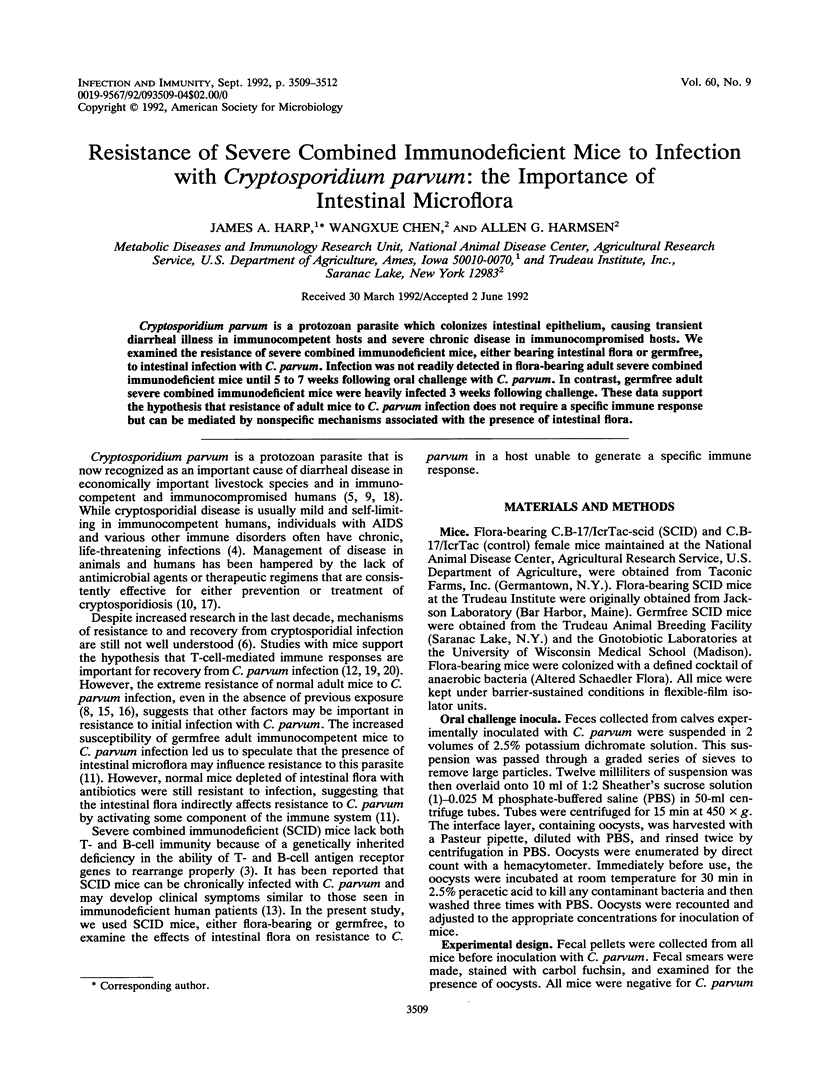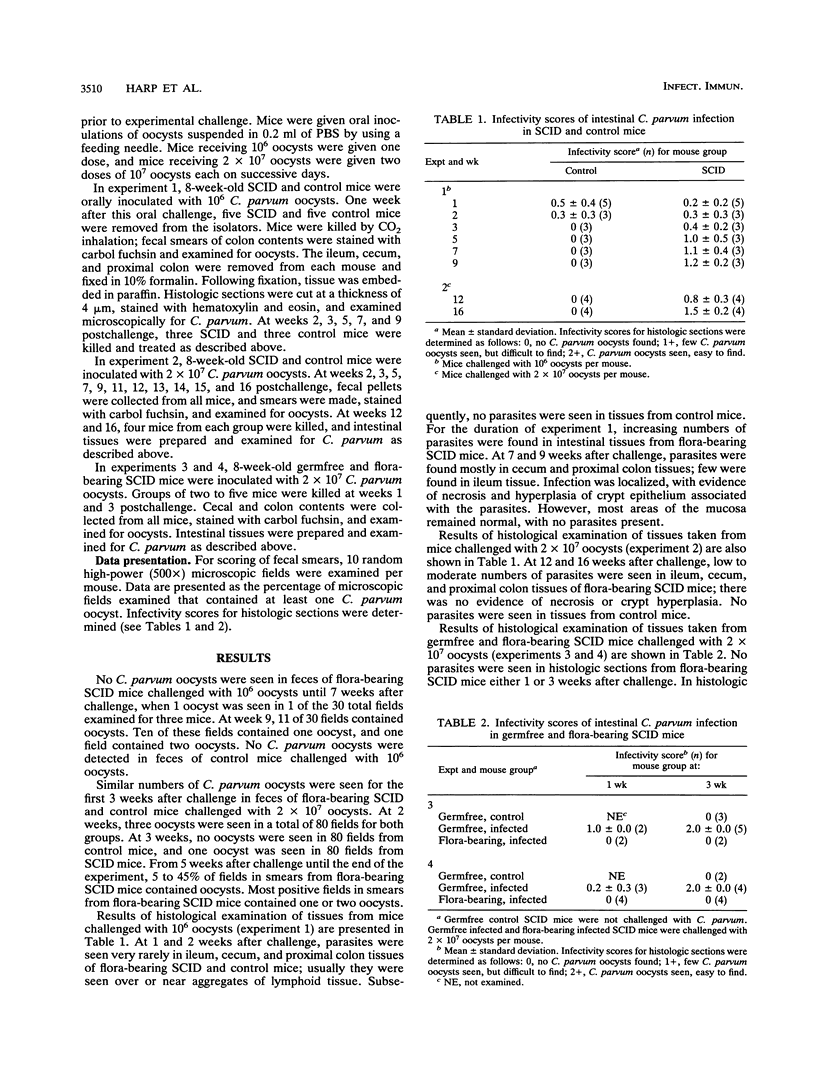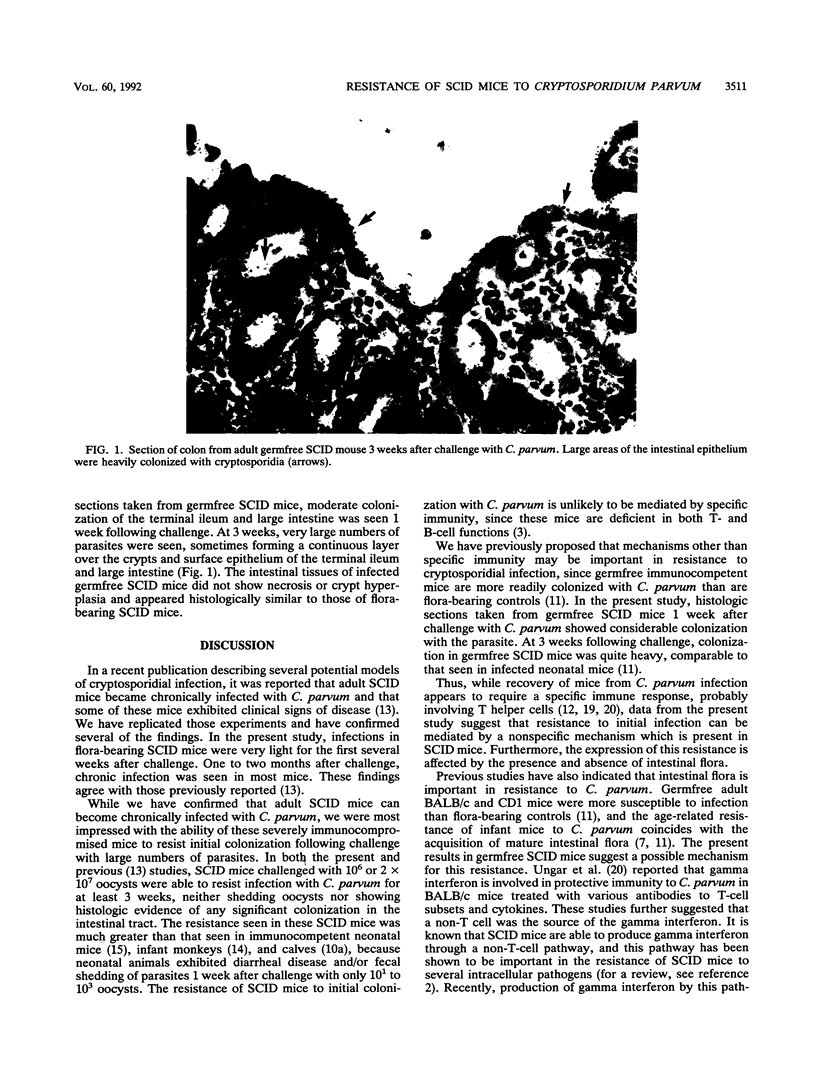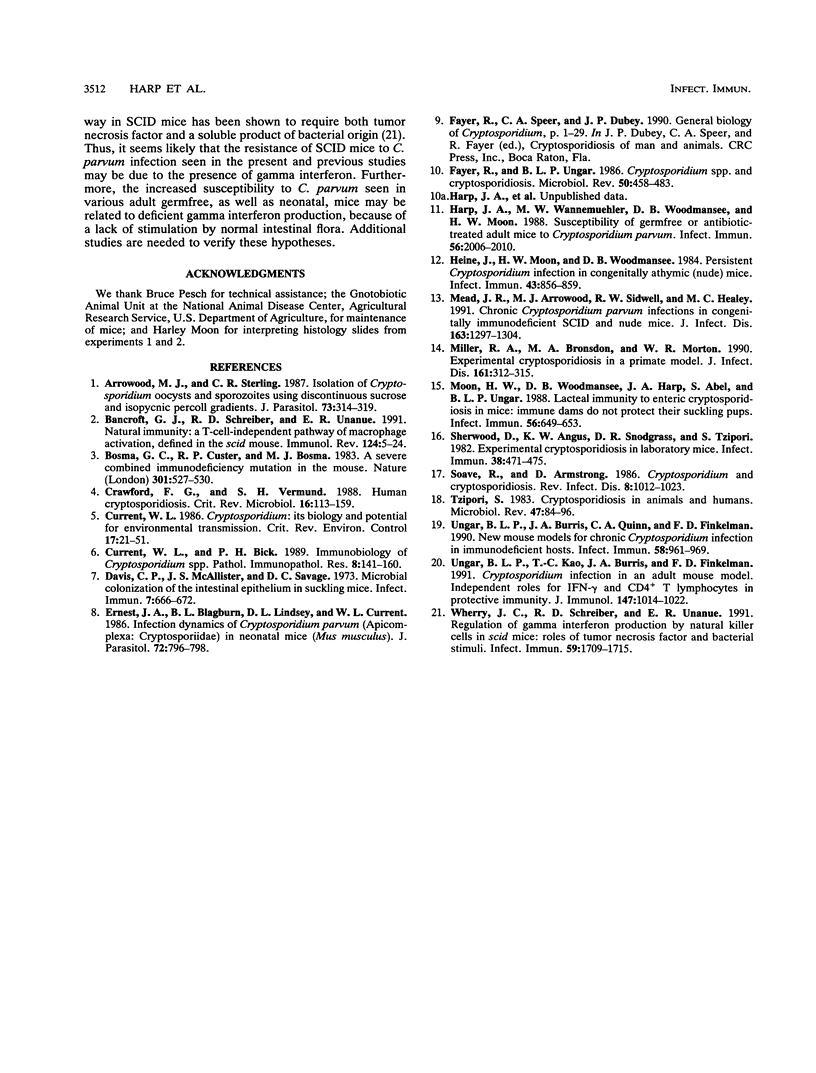Abstract
Cryptosporidium parvum is a protozoan parasite which colonizes intestinal epithelium, causing transient diarrheal illness in immunocompetent hosts and severe chronic disease in immunocompromised hosts. We examined the resistance of severe combined immunodeficient mice, either bearing intestinal flora or germfree, to intestinal infection with C. parvum. Infection was not readily detected in flora-bearing adult severe combined immunodeficient mice until 5 to 7 weeks following oral challenge with C. parvum. In contrast, germfree adult severe combined immunodeficient mice were heavily infected 3 weeks following challenge. These data support the hypothesis that resistance of adult mice to C. parvum infection does not require a specific immune response but can be mediated by nonspecific mechanisms associated with the presence of intestinal flora.
Full text
PDF



Images in this article
Selected References
These references are in PubMed. This may not be the complete list of references from this article.
- Arrowood M. J., Sterling C. R. Isolation of Cryptosporidium oocysts and sporozoites using discontinuous sucrose and isopycnic Percoll gradients. J Parasitol. 1987 Apr;73(2):314–319. [PubMed] [Google Scholar]
- Bancroft G. J., Schreiber R. D., Unanue E. R. Natural immunity: a T-cell-independent pathway of macrophage activation, defined in the scid mouse. Immunol Rev. 1991 Dec;124:5–24. doi: 10.1111/j.1600-065x.1991.tb00613.x. [DOI] [PubMed] [Google Scholar]
- Bosma G. C., Custer R. P., Bosma M. J. A severe combined immunodeficiency mutation in the mouse. Nature. 1983 Feb 10;301(5900):527–530. doi: 10.1038/301527a0. [DOI] [PubMed] [Google Scholar]
- Crawford F. G., Vermund S. H. Human cryptosporidiosis. Crit Rev Microbiol. 1988;16(2):113–159. doi: 10.3109/10408418809104469. [DOI] [PubMed] [Google Scholar]
- Current W. L., Bick P. H. Immunobiology of Cryptosporidium spp. Pathol Immunopathol Res. 1989;8(3-4):141–160. doi: 10.1159/000157146. [DOI] [PubMed] [Google Scholar]
- Davis C. P., McAllister J. S., Savage D. C. Microbial colonization of the intestinal epithelium in suckling mice. Infect Immun. 1973 Apr;7(4):666–672. doi: 10.1128/iai.7.4.666-672.1973. [DOI] [PMC free article] [PubMed] [Google Scholar]
- Ernest J. A., Blagburn B. L., Lindsay D. S., Current W. L. Infection dynamics of Cryptosporidium parvum (Apicomplexa: Cryptosporiidae) in neonatal mice (Mus musculus). J Parasitol. 1986 Oct;72(5):796–798. [PubMed] [Google Scholar]
- Fayer R., Ungar B. L. Cryptosporidium spp. and cryptosporidiosis. Microbiol Rev. 1986 Dec;50(4):458–483. doi: 10.1128/mr.50.4.458-483.1986. [DOI] [PMC free article] [PubMed] [Google Scholar]
- Harp J. A., Wannemuehler M. W., Woodmansee D. B., Moon H. W. Susceptibility of germfree or antibiotic-treated adult mice to Cryptosporidium parvum. Infect Immun. 1988 Aug;56(8):2006–2010. doi: 10.1128/iai.56.8.2006-2010.1988. [DOI] [PMC free article] [PubMed] [Google Scholar]
- Heine J., Moon H. W., Woodmansee D. B. Persistent Cryptosporidium infection in congenitally athymic (nude) mice. Infect Immun. 1984 Mar;43(3):856–859. doi: 10.1128/iai.43.3.856-859.1984. [DOI] [PMC free article] [PubMed] [Google Scholar]
- Mead J. R., Arrowood M. J., Sidwell R. W., Healey M. C. Chronic Cryptosporidium parvum infections in congenitally immunodeficient SCID and nude mice. J Infect Dis. 1991 Jun;163(6):1297–1304. doi: 10.1093/infdis/163.6.1297. [DOI] [PubMed] [Google Scholar]
- Miller R. A., Bronsdon M. A., Morton W. R. Experimental cryptosporidiosis in a primate model. J Infect Dis. 1990 Feb;161(2):312–315. doi: 10.1093/infdis/161.2.312. [DOI] [PubMed] [Google Scholar]
- Moon H. W., Woodmansee D. B., Harp J. A., Abel S., Ungar B. L. Lacteal immunity to enteric cryptosporidiosis in mice: immune dams do not protect their suckling pups. Infect Immun. 1988 Mar;56(3):649–653. doi: 10.1128/iai.56.3.649-653.1988. [DOI] [PMC free article] [PubMed] [Google Scholar]
- Sherwood D., Angus K. W., Snodgrass D. R., Tzipori S. Experimental cryptosporidiosis in laboratory mice. Infect Immun. 1982 Nov;38(2):471–475. doi: 10.1128/iai.38.2.471-475.1982. [DOI] [PMC free article] [PubMed] [Google Scholar]
- Soave R., Armstrong D. Cryptosporidium and cryptosporidiosis. Rev Infect Dis. 1986 Nov-Dec;8(6):1012–1023. doi: 10.1093/clinids/8.6.1012. [DOI] [PubMed] [Google Scholar]
- Tzipori S. Cryptosporidiosis in animals and humans. Microbiol Rev. 1983 Mar;47(1):84–96. doi: 10.1128/mr.47.1.84-96.1983. [DOI] [PMC free article] [PubMed] [Google Scholar]
- Ungar B. L., Burris J. A., Quinn C. A., Finkelman F. D. New mouse models for chronic Cryptosporidium infection in immunodeficient hosts. Infect Immun. 1990 Apr;58(4):961–969. doi: 10.1128/iai.58.4.961-969.1990. [DOI] [PMC free article] [PubMed] [Google Scholar]
- Ungar B. L., Kao T. C., Burris J. A., Finkelman F. D. Cryptosporidium infection in an adult mouse model. Independent roles for IFN-gamma and CD4+ T lymphocytes in protective immunity. J Immunol. 1991 Aug 1;147(3):1014–1022. [PubMed] [Google Scholar]
- Wherry J. C., Schreiber R. D., Unanue E. R. Regulation of gamma interferon production by natural killer cells in scid mice: roles of tumor necrosis factor and bacterial stimuli. Infect Immun. 1991 May;59(5):1709–1715. doi: 10.1128/iai.59.5.1709-1715.1991. [DOI] [PMC free article] [PubMed] [Google Scholar]



